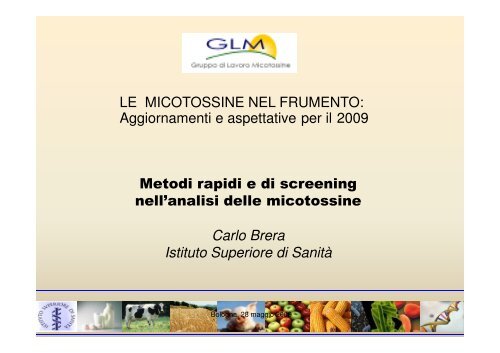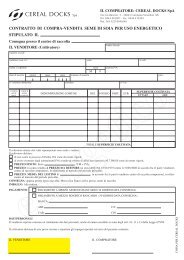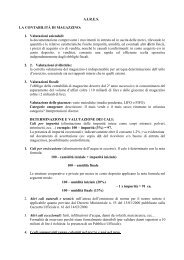Carlo Brera - Istituto Superiore di SanitÃ
Carlo Brera - Istituto Superiore di SanitÃ
Carlo Brera - Istituto Superiore di SanitÃ
You also want an ePaper? Increase the reach of your titles
YUMPU automatically turns print PDFs into web optimized ePapers that Google loves.
LE MICOTOSSINE NEL FRUMENTO:Aggiornamenti e aspettative per il 2009Meto<strong>di</strong> rapi<strong>di</strong> e <strong>di</strong> screeningnell’analisi delle micotossine<strong>Carlo</strong> <strong>Brera</strong><strong>Istituto</strong> <strong>Superiore</strong> <strong>di</strong> SanitàBologna, 28 maggio 2009
• Sono sostanze dotate <strong>di</strong> elevato potere cancerogeno• Sono sostanze che manifestano tossicità croniche e raramente acute• Sono sostanze termostabili• Sono fortemente elettrostatiche• Sono ubiquitariamente presenti sul territorio• Presentano una tipologia <strong>di</strong> contaminazione eterogenea(a macchia <strong>di</strong> leopardo)• Non presentano <strong>di</strong>fficoltà da un punto <strong>di</strong> vista <strong>di</strong> determinazione analitica
Regolamento CE/1126/2007 dellaCommissione del 28 settembre2007che mo<strong>di</strong>fica il regolamento 1881/2006 chedefinisce i tenori masimi <strong>di</strong> alcunicontaminanti nei prodotti alimentari perquanto riguarda le Fusarium tossine nelgranoturco e nei prodotti derivati
Regolamento CE/1126/2007Considerando 34E’ opportuno stabilire tenori massimi <strong>di</strong>Fusarium-tossine per i cereali non trasformaticommercializzati per la prima trasformazione.I proce<strong>di</strong>menti <strong>di</strong> pulizia, cernita edessiccazione NON sono considerati partedella prima trasformazione se non vieneesercitata alcuna azione fisica sullacariosside, mentre la decorticazione vaconsiderata parte della prima trasformazione
Regolamento 1126/2007
Distribuzione del DON nel processo <strong>di</strong> molitura del grano3500300030002500+143%2000150012501000500950 950-25%700-25%600- 37%0
Andamento processo produttivo- ROSA test - DON• Il processo <strong>di</strong> decorticazione produceun abbattimento dal 20 al 30%• Concentrazione nel tritello efarinaccio dal 150% al 250 %• Nella semola non si osservanoabbattimenti
La filiera analiticaCampionamentoPreparazioneDel campioneAnalisi Quali/quantitativa
7 tDAL CAMPO AL BANCONE1 : 600.0000.00016 % 30 t5 kg1 kg50 grammi
Campionamento• Procedure conformi al Regolamento CE/401/2006(Controllo ufficiale)• Da evitare il controllo nei silos• Da preferire quello sui camion in con<strong>di</strong>zioni <strong>di</strong>namichepiuttosto che statiche• Campionatori automaticiPER OTTENERE INFORMAZIONI ATTENDIBILISI DEVE INVESTIRE SUL CAMPIONAMENTO
Preparazione del campione• Macinazione del campione globale fino agranulometria fine• Omogeneizzazione del campione macinato asecco o con acqua• Prelievo in modo rappresentativo <strong>di</strong>un’aliquota da destinare all’analisi
Macinazione con acqua(slurry)
MycotoxinAflatoxinsTrichothecenes(type A)Trichothecenes(type B)ZearalenoneOchratoxin AFumonisinsExtraction solventacetonitrile/water, methanol/water,acetone/wateracetonitrile/water, methanol/wateracetonitrile/water, water (DON)acetonitrile/water, methanol, acetonitrilechloroform/H 3 PO 4 , acetonitrile/water,methanolo/3% NaHCO 3 , toluene/HCl/MgCl 2methanol/water, acetonitrile/water,acetonitrile/methanol/water
Purificazione• Colonnine <strong>di</strong> immunoaffinità (Euroclone, R-Biopharm, Romer, VICAM)• Colonnine <strong>di</strong> immunoaffinità rigenerabili(Euroclone, Generon)• MycoSep®/MultiSep® columns (Romer)• Colonnine multi-micotossina (R-BiopharmRHONE, Romer, VICAM)
DON – HPLC-UVMetodo ISS• Principio del metodo: estrazione conacqua• Purificazione su CIA• Determinazione per HPLC con rivelazioneUV a 220 nm• Fase mobile : Acqua: MeOH 85:15(isocratica)• LQ: 0.050 mg/kg
DON – Meto<strong>di</strong> <strong>di</strong> screening• Estrazione con acqua• Chiarificazione dell’ estratto• Diluizione• Incubazione• Lettura
Regolamento EC 882/2004Caratterizzazione dei meto<strong>di</strong> <strong>di</strong> analisi• Accuratezza• Applicabilità (matrice e concentrazione)• LR/LQ• Precisione (ripe/riproducibilità)• Recupero• Selettività• Sensibilità• Linearità• Incertezza <strong>di</strong> misura
Meto<strong>di</strong> <strong>di</strong> screening e/o rapi<strong>di</strong>• Elevato numero <strong>di</strong> campioni per <strong>di</strong>e• Interesse ad in<strong>di</strong>viduare un livello soglia (ad esempio limite legale)• Diversità delle matrici da analizzare• Differenti sostanze da ricercare• Rapi<strong>di</strong>tà <strong>di</strong> risposta• Sensibilità accettabile• Bassa cross-reattività• Contenimento dei costi• Esperienza del personale• Possibilità <strong>di</strong> utilizzo in-situSi rivolgono principalmente alleaziende nello svolgimento delleattività <strong>di</strong> autocontrolloImpiego nella ricerca
Tipi <strong>di</strong> test• Test qualitativi con cut-off (rispostasi/no) risposta visuale/lettore• Test quantitativi che richiedono unreader ottico o scanner per la letturadella concentrazione
Scelta della strategia <strong>di</strong> controllo• Laboratorio interno• Laboratorio esternoAttrezzato??Esperto??• Meto<strong>di</strong> ufficiali• Meto<strong>di</strong> rapi<strong>di</strong>• Meto<strong>di</strong> <strong>di</strong> screening• Meto<strong>di</strong> <strong>di</strong> conferma
Meto<strong>di</strong> ufficiali e <strong>di</strong> riferimentoMicotossina Matrice Metodo PRINCIPIOAFLATOSSINE CerealI AOAC-991.31 IAC-HPLC-FLDAFLATOSSINE Mais AOAC-993.16 ELISAAflatossina B1 Mangimi AOAC-2003.02IAC-HPLC-FLDCEN-ISO 17375:2006Aflatossina B1 Baby foods AOAC-2000.16 IAC-HPLC-FLDOcratossina A Cereali e Prodotti Derivati CEN-ISO 15141-1:1998 IAC-HPLC-FLDOcratossina A Mais ed orzo AOAC-991.44 IAC-HPLC-FLDOcratossina A ORZO AOAC-2000.03 IAC-HPLC-FLD
Meto<strong>di</strong> ufficiali e <strong>di</strong> riferimentoMicotossina Matrice Metodo PRINCIPIOOcratossina A Orzo CEN-ISO 14132:2003 IAC-HPLC-FLDOcratossina A Baby foods CEN - IN VIA DIAPPROVAZIONEIAC-HPLC-FLDDeossinivalenolo Grano AOAC-986-18 IAC-HPLC-UVDeossinivalenolo Cereali e prodotti derivati CEN - IN VIA DIAPPROVAZIONEDeossinivalenolo Baby foods CEN - IN VIA DIAPPROVAZIONEIAC-HPLC-UVIAC-HPLC-UVDeossinivalenolo Grano AOAC-986.17 IAC-HPLC-UVZearalenone Mais AOAC-985.18 IAC-HPLC-FLD
Micotossina Matrice Metodo PRINCIPIOZearalenone Cereali e prodotti derivati CEN - IN VIA DIAPPROVAZIONEZearalenone Baby foods CEN - IN VIA DIAPPROVAZIONEIAC-HPLC-FLDIAC-HPLC-FLDZearalenone Grano e mangimi AOAC-994.01 ELISA qualitativoZearalenone Mais AOAC-976.22 TLCFumonisine Mais AOAC-995.15 HPLCFumonisine Prodotti alimentari a base <strong>di</strong> mais AOAC-2001.04;CEN-ISO14352:2005IAC-HPLC-FLDFumonisine Mais CEN 13585:2002 SPE-HPLC conderivatizzazione pre-colonnaFumonisine Mais AOAC-2001.06 ELISAFumonisine Baby foods CEN - IN VIA DIAPPROVAZIONEIAC-HPLC-FLD
Metodologie analitiche a confrontoMetodologia Vantaggi SvantaggiHPLC/UPLCLC/MS/MSELISAOttima sensibilitàOttima selettivitàBuona ripetibilitàTempi <strong>di</strong> analisi relativamente breviMeto<strong>di</strong> ufficiali <strong>di</strong>sponibili (AOAC)Possibilità <strong>di</strong> automatizzazioneSimultanea analisi <strong>di</strong> più micotossineBuona sensibilitàCostituisce metodo <strong>di</strong> confermaNon è necessaria la derivatizzazionePreparazione del campione sempliceEquipaggiamento me<strong>di</strong>amente costosoAlta sensibilitàValida per screeningAnalisi simultanea <strong>di</strong> molti campioniCosto della strumentazioneCosto dell’analisiEsperienza del personaleDerivatizzazione (aflatossine, fumonisina)Uso <strong>di</strong> solventi organiciCosti elevati della strumentazioneEffetti matriceAlta esperienza del personaleCross-reattività con altre micotossine(specificità)Effetti matricePresenza <strong>di</strong> falsi positivi/negativiRichiede analisi <strong>di</strong> confermaRipetibilità e riproducibilità criticheEsperienza del personale
ELISA principlesDirect competitive ELISAThe antibody is coated on to the wells of theELISA plate.The test sample and the enzymelabelledmycotoxin conjugate are added tothe wells. If no toxin is present in the sample,the enzyme labelled toxin will bind to thecapture antibody coated to the wells. If toxinis present in the sample, it will compete withthe labelled toxin for bin<strong>di</strong>ng to the antibody.During washing procedures any unboundlabelled enzyme will be washed away. On thead<strong>di</strong>tion of substrate, a colour will develop,the intensity of which is proportional to theamount of mycotoxin-enzyme bound to thewell; i.e., the colour intensity decreases withincreasing concentrations of the toxin in thesample.
DON - Cross reattivitàNei kit ELISA commercialmente <strong>di</strong>sponibili, èpossibile l’esistenza <strong>di</strong> cross-reattività con alcunimetaboliti del DON che portano ad unasovrastima dei risultati- DON-3-glucoside- AcetilDON- 3-OH DON- 15-OH DONDIPARTIMENTO DI SANITA’ PUBBLICA VETERINARIA E SICUREZZA ALIMENTARE
Hana Jaslova, 2008DIPARTIMENTO DI SANITA’ PUBBLICA VETERINARIA E SICUREZZA ALIMENTARE
DIPARTIMENTO DI SANITA’ PUBBLICA VETERINARIA E SICUREZZA ALIMENTARE
STUDIO INTERLABORATORIO.METODO IMMUNOENZIMATICO PER LADETERMINAZIONE DEL DEOSSINIVALENOLO INCAMPIONI DI GRANO TENERO<strong>Carlo</strong> <strong>Brera</strong>, Francesca Debegnach, Elisabetta Prantera, Marina MiragliaReparto OGM e MicotossineDipartimento <strong>di</strong> Sanità Pubblica Veterinaria e Sicurezza Alimentare<strong>Istituto</strong> <strong>Superiore</strong> <strong>di</strong> Sanità
Caratteristiche <strong>di</strong> efficienza - ELISA≤ 20%≤ 40%70-110%
Progetto MICOCER - DON nel frumentoCONFRONTO HPLC vs ELISA2500HPLC200015001000y = xR² = 1y = 0,7969x + 5,0687R² = 0,9992Lineare (HPLC v.s.ELISA )Lineare (retta 45)50000 500 1000 1500 2000 2500ELISASOVRASTIMA COSTANTE
ParametriDON (µg/kg)Materiali 1 2 3 4 5 6 Valori UEValori assegnati < LOQ 213 3299 1055 992 1572Valori <strong>di</strong> riferimento < LOQ 191 2934 800 1062 1323Anno 2008Numero dei lab 10 10 10 10 10 10Numero dei lab dopooutliers10 10 10 10 10Numero <strong>di</strong> outliers 0 0 0 0 0Numero <strong>di</strong> risultatiaccettati10 10 10 10 10Numero <strong>di</strong> repliche 2 2 2 2 2Me<strong>di</strong>a, µg/kg 211 3380 1013 998 1540Sr , µg/kg 36 505 137 172 330RSDr, % 17.3 15.0 13.6 17.3 21.4 ≤ 20r (=2,8xSr) µg/kg 101 1414 384 482 924SR, µg/kg 67 524 239 185 363RSDR , % DIPARTIMENTO DI SANITA’ 31.6 PUBBLICA 15.5 VETERINARIA 23.5 E SICUREZZA 18.6 ALIMENTARE 23.5 ≤ 40R (=2,8xSR) µg/kg 188 1467 669 518 1016Recupero, % 111 115 127 94 116 60-120
Andamento del kit ELISA rispetto al valore <strong>di</strong> riferimento ottenuto dall’analisi in HPLC per lo stu<strong>di</strong>o <strong>di</strong>validazione interlaboratorio per la determinazione del DON in campioni <strong>di</strong> grano tenero (2008/2009).HPLC3500300025002000150010005000y = xR 2 = 1y = 0.882x + 4.1165R 2 = 0.98650 500 1000 1500 2000 2500 3000 3500ELISADIPARTIMENTO DI SANITA’ PUBBLICA VETERINARIA E SICUREZZA ALIMENTARE
Confronto ELISA – GC/MSDr.ssa Emma Tealdo VENETO AGRICOLTURA - <strong>Istituto</strong> per la Qualità e le Tecnologie Agroalimentari, 2008
Comparison of ELISA and HPLC methods to determineconcentrations of aflatoxins (ppb) in Sicilian durumwheat grain in 2006. (Gallo, 2008)
Principi teorici del Lateral Flow Device (LFD)L’LFD competitivo si basa sulla competizione della micotossina presentenel campione con i siti attivi <strong>di</strong> un recettore anticorpale marcato per i sitiattivi <strong>di</strong> un complesso coniugato micotossina - recettore. La linea testcontiene un complesso coniugato - micotossina immobilizzato allamembrana che lega il recettore non legato per formare un complessoconiugato micotossina-recettore colorato. La linea <strong>di</strong> controllo include unanticorpo specifico legato alla membrana che si lega con il recettoremarcato. Il legame comporta una colorazione della banda. Se il segnalenella linea test è mancante o più debole come intensità, il test in<strong>di</strong>ca chel’analita è presente (test positivo). Se la linea test è chiaramente visibile,vuol <strong>di</strong>re che il campione non contiene la micotossina
LATERAL FLOW DIPSTICKMetodo Rapido
800DON - Correlazione HPLC-LFDy = 1,226x + 10,51R² = 0,836700HPLC60050040030020010000 100 200 300 400 500 600 700SOTTOSTIMARosa Test (ug/KG)
Don - Correlazione HPLC-LFDLFD800TRITELLOy = 0,920x + 123,6R² = 0,501700HPLC (ug/Kg)6005004003002001000LFD (ug/Kg)0 100 200 300 400 500 600 700sottostima costante
Meto<strong>di</strong> rapi<strong>di</strong>Metodologia Vantaggi SvantaggiLateral flow<strong>di</strong>psticks(LFD)Strip testRapi<strong>di</strong>tà <strong>di</strong> esecuzioneNon è necessaria la purificazioneBasso costo della apparecchiaturaFacile da usareNon necessaria alta qualifica delpersonaleDiscreta esattezzaCosti operativi me<strong>di</strong>Buona sensibilità (limiti <strong>di</strong> legge)Costi operativi me<strong>di</strong>o-bassiUso limitato <strong>di</strong> solventi organiciVali<strong>di</strong> per test <strong>di</strong> screeningPossibilità <strong>di</strong> essere utilizzati in locoEffetto matricePossibilità <strong>di</strong> falsi positivi/negativiMeto<strong>di</strong> esistenti non validatiTest qualitativi (soglia)Cross-reattività con altre micotossinePrecisione critica
Alcuni prodotti per il DONELISAR5901 RIDASCREEN ® FAST DON• R5902 RIDASCREEN ® FAST DON• R5905 RIDASCREEN ® FAST DON SC• R5906 RIDASCREEN ® DONCampo <strong>di</strong> concentrazioni: 0 – 6 mg/kgCross reattività: determina anche il 3-Acetil-DON – LQ: 18.5 µg/kgColonnine <strong>di</strong> immunoaffinità• P50 / P50B DONPREP ®Lateral flow test• R5904 RIDA ® QUICK DONLivello soglia ≥ 1.25 mg/kg o : ≥ 0.5 mg/kgTempo <strong>di</strong> incubazione: 5 minStandards• P63 DEOXYNIVALENOL STANDARD : Concentrazione : 100 µg/mlMateriali <strong>di</strong> Riferimento• P64-D Deoxynivalenol Reference MaterialAzienda: R-Biopham Rhone
Colonnine <strong>di</strong> immunoaffinità• DON TEST : Campo <strong>di</strong> concentrazione 0.1 – 10 mg/kgAzienda: VICAMColonnine <strong>di</strong> immunoaffinità• MycoSep®/MultiSep®ELISA Test Kits:• AgraQuant ® DON: Campo <strong>di</strong> concentrazione 0.25 – 5 mg/kg : LOQ: 0.2 mg/kg; tempo <strong>di</strong> incubazione: 20 minAccuTox® DON: LOQ: 0.5 mg/kgLateral Flow Test Kits:AgraStrip® DON: Campo <strong>di</strong> concentrazione: 0.5 – 5 mg/kg. Tempo <strong>di</strong> incubazione: 4 minStandards: Concentrazione - 100 µg/mLAzienda : ROMER LABS
Lateral Flow Test Kits:• ROSA TEST : campo <strong>di</strong> concentrazione : 0 – 6 mg/kgAzienda: CHARM/FOSSELISA Test Kits:• KIT AGRI-SCREEN (analisi qualitativa) – Controllo a 1 mg/kg; Tempo <strong>di</strong> analisi 10 min; cross-R 3-acetyl DON• KIT VERATOX (analisi quantitativa) - Vomitossina HS – DON: Campo <strong>di</strong> concentrazioni: 0.025-0.250 mg/kg; TA=20 mi• Vomitossina 5/5 – DON Campo <strong>di</strong> concentrazione: 0.25 – 3 mg/kg; TA = 10 minLateral Flow Dipsticks :• REVEAL DON : Reveal DON – CUT OFF: 2 mg/kg; TA= 6 minColonnine <strong>di</strong> immunoaffinitàAZIENDA DIESSECHEM
ELISA KIT Quantitativo 96 e 48 pozzettiLateral Flow Dipsticks STRIP TEST DON : Campo <strong>di</strong> concnetrazione: 0,5 - 1 - 2 mg/kgAZIENDA: ASTORIELISA• Deossinivalenolo Elisa Kit: campo <strong>di</strong> concentrazione 0 – 10 mg/kg; LQ = 0.5 mg/kg; TA=20 – 30 minAZIENDA: EUROCLONEELISA• DON GOLD (VT344/345): campo <strong>di</strong> concentrazione 0.05 – 5 mg/kg; LQ:0.05 mg/kg; TA=30 minAZIENDA: TECNA
I meto<strong>di</strong> immunoenzimatici possono presentare sia una leggerasovrastima sia una sottostima rispetto al dato ottenuto dall’analisi inHPLCIl metodo immunoenzimatico per la determinazione deldeossinivalenolo nel grano mostra un andamento sod<strong>di</strong>sfacente perun’analisi <strong>di</strong> screening anche se in presenza <strong>di</strong> una leggerasovrastimaConfrontando i risultati ottenuti negli stu<strong>di</strong> interlaboratorio con iparametri riportati nel Regolamento 401/2006, si può affermare cheesiste un sostanziale accordo, anche in considerazione del fatto che iparametri <strong>di</strong> riferimento riportati nel Regolamento riguardano meto<strong>di</strong><strong>di</strong> conferma
3°Congresso NazionaleLe micotossine nella filieraagroalimentare e zootecnica<strong>Istituto</strong> <strong>Superiore</strong> <strong>di</strong> Sanità28-30 settembre 2009
<strong>Carlo</strong> <strong>Brera</strong><strong>Istituto</strong> <strong>Superiore</strong> <strong>di</strong> SanitàDipartimento <strong>di</strong> Sanità Pubblica Veterinaria e SicurezzaAliementare (DSPVSA)Reparto OGM e MicotossineTel. 06-49902377E-mail: carlo.brera@iss.it
Title: Masked mycotoxins: determination of a deoxynivalenol glucoside in artificially and naturally contaminatedwheat by liquid chromatography-tandem mass spectrometry.Personal Authors: Berthiller, F., Dall'Asta, C., Schuhmacher, R., Lemmens, M., Adam, G., Krska, R.Author Affiliation: Christian Doppler Laboratory for Mycotoxin Research, Institute for Plant ProductionBiotechnology, Department for Agrobiotechnology (IFA-Tulln), University of Natural Resources and Applied LifeSciences, Vienna, Konrad Lorenz Strasse 20, A-3430 Tulln, Austria.E<strong>di</strong>tors: No e<strong>di</strong>torsDocument Title: Journal of Agricultural and Food ChemistryAbstract: Conjugated mycotoxins, in which the toxin is usually bound to a more polar substance like glucose,are referred to as masked mycotoxins, as these substances escape routine detection methods but can releasetheir toxic precursors after hydrolysis. This is the first report on the natural occurrence of a glucoside ofdeoxynivalenol (DON) in Fusarium-infected wheat and maize. To obtain appropriate standards, we chemicallysynthesized deoxynivalenol-3-β-D-glucopyranoside (DON-3-glucoside) and deoxynivalenol-15-β-Dglucopyranoside(DON-15-glucoside). The synthesis products were characterized by liquid chromatography-tandem mass spectrometry. The DON-glucosides showed <strong>di</strong>fferent collision-induced <strong>di</strong>ssociation (CID)fragmentation behaviors and could therefore be <strong>di</strong>stinguished. Wheat plants were either treated with DON (n=52)or with Fusarium spp. (n=4) at anthesis, and after harvest, wheat ears were analyzed for DON and DONglucosides.All 56 treated wheat samples contained DON and a DON-glucoside with the same retention time,molecular mass, and CID fragmentation behavior as the synthetic DON-3-glucoside. Moreover, the DONglucosidewas also found in two out of three analyzed naturally DON-contaminated maize and in five out of fivenaturally contaminated wheat samples, in a range from 4 to 12% of the DON concentration. To further confirmthe identity of the DON-glucoside, the compound was isolated from wheat extracts and characterized as DON-3-glucoside with NMR. The results of this study in<strong>di</strong>cate the importance to consider both DON and DON-3-glucoside with regard to food and feed safety.Publisher: American Chemical Society<strong>Carlo</strong> <strong>Brera</strong>
Analysis of deoxynivalenol, masked deoxynivalenol, and Fusarium graminearumpigment in wheat samples, using liquid chromatography-UV-mass spectrometry.Full AbstractTolerable limits set for deoxynivalenol (DON) do not consider DON conjugates such asDON-3-glucoside. Conjugates may be metabolized in vivo to DON. Such maskedmycotoxins and the potentially toxic Fusarium pigment are not routinely analyzed in cereals.We quantified DON, DON-3-glucoside, and a red Fusarium pigment in hard red springwheat, using a new liquid chromatography-mass spectrometry method. Extraction protocolsusing centrifugation and shaking, and methanol-methylene chloride (50:50 [vol/vol]) oracetonitrile-water (84:16 [vol/vol]) were assessed. Purposively and randomly selected hardspring wheat samples were extracted with solvent filtered through a C18 column andanalyzed using liquid chromatography-UV-mass spectrometry. Isocratic mobile phase (70%methanol) was used. Recoveries were 96.4% (DON) and 70.0% (DON-3-glucoside), whilelimits of detection were 1 microg/kg (MS) and 10 microg/kg (UV), and limits of quantificationwere 1 microg/kg (UV) and 0.5 microg/kg (MS), respectively. The pigment limits ofquantification and limits of detection on the MS were 4.3 and 0.0005 microg/kg, respectively.The purposively selected samples had DON, DON-3-glucoside, and pigment averages of3.4 +/- 4.0 microg/g, 3.8 +/- 8.3 microg/g, and 0.31 +/- 3.71 g/kg, respectively. The randomlyselected spring wheat had lower mean levels of DON (1.4 +/- 2.3 microg/g), DON-3-glucoside (0.2 +/- 1.0 microg/g), and pigment (147.93 +/- 247.84 microg/g). Analytical toolssuch as this new liquid chromatography-UV-mass spectrometry method can be used toquantify masked and parent mycotoxins, plus a potentially toxic pigment for riskassessment.Journal of food protection (J Food Prot), published in United States. (Language: eng)Reference: 2008-Jun; vol 71 (issue 6) : pp 1205-13<strong>Carlo</strong> <strong>Brera</strong>





![C[1].tto 103 - Granoturco nazionale - Inter-Associativo](https://img.yumpu.com/24141627/1/184x260/c1tto-103-granoturco-nazionale-inter-associativo.jpg?quality=85)



